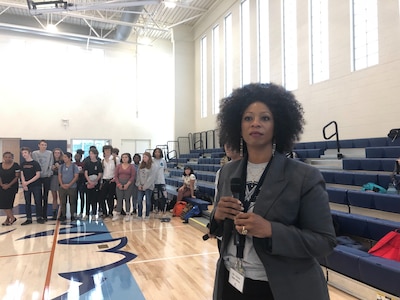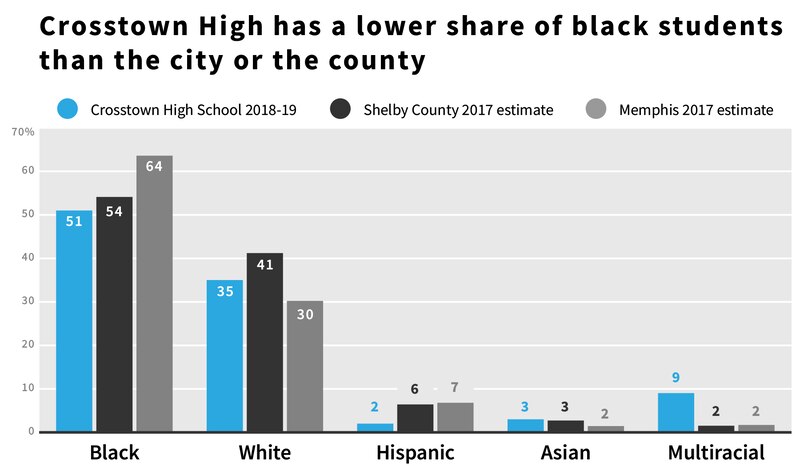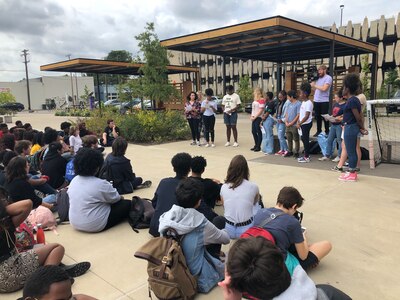More than 100 students at a Memphis high school left their classrooms Friday morning, walked around the giant Crosstown Concourse building, and read a letter to their administration calling for significant changes.
The letter outlines grievances, and possible solutions of students at Crosstown High School — you can read the letter in full below — and its reading was followed by a town hall between students and Principal Alexis Gwin-Miller, in her first year at the two-year-old school.
The letter called for the school to change its cohort model, where students in the same grade are divided into separate groups that take classes together, which they say has created segregation in the school. The letter also said the school isn’t the innovative, project-based model they had hoped for.
“I don’t think the school has completely ignored us on purpose, but they have neglected student voice on big decisions like the cohort model,” said 10th-grader Pamela Joyce Crimiel. “We’re not just talking down on Crosstown, there’s no school like it in Memphis. But they need to stop talking about changes, and actually move on what we’ve told them we need.”
Crosstown was part of a wave of schools seeking to “reimagine high school” thanks to funding from XQ, the nonprofit backed by Laurene Powell Jobs. XQ is one of the most ambitious and best-funded school reform initiatives. Crosstown High has received $2.5 million of XQ funding.
Crosstown was meant to look vastly different from a traditional high school.
No classrooms arranged with rows of desks. No high-stakes tests. No failing grades. It joined a growing group of other U.S. schools grounded in mastery-based learning, which emphasizes student-led projects over teacher lectures.
The student-led protest is a significant moment for the charter high school as it tries to establish its new education model. Currently, 279 students are enrolled in the school that is housed in Crosstown Concourse, a huge redeveloped high-rise building that once was a Sears warehouse.

Following the protest, students walked back around the Crosstown building to the school’s new gym for a meeting with administration and teachers that lasted more than an hour. Dozens of students asked questions about changes to the school’s structure and curriculum, why some teachers were switched to new classrooms, and whether or not the leaders would address their request to have students represented in decision-making.
Gwin-Miller said she was proud of the students and that the school is “taking a second look at where we are.”
“What we will do? Gwin-Miller told the students. “We will have an opportunity for everyone coming together to work on solutions. We will hear your voices. You guys asked for that, that’s part of the plan.”
Students said the issue that “sparked most of the current collective frustration of the student body” stems from the school’s cohort model.
“The issue is in how it’s being implemented,” one student said as they read the letter out loud at the rally. “There is an unfair distribution of students between the two 10th-grade cohorts that, whether intentionally or not, limits diversity in both cohorts. A large majority of black and minority students in the 10th grade are in cohort B, where as most of the white students are in cohort A.”
Achieving racial and economic diversity has been a significant goal for the new high school ever since leaders first began discussing what Crosstown should look like in a city with a long history of racial strife and poverty. Some education advocates worried privately that the school could end up serving wealthier white families at the expense of 65 percent of students in Shelby County School who are from low-income families.
Parent Shiloh Barnat-Goodman said her daughter, who is white and in cohort A, receives resources that the other group does not, such as an advisory period and a smaller student-to-teacher ratio.
In the waning moments of the town hall, students split themselves off by cohort across the gym from one another to show the school administration how segregated they believe the cohorts are.

Related: Designing diversity: How one Memphis charter school set out to recruit its students
Gwin-Miller said the cohorts were designed for students to “get what you need,” and did not specify whether the model would change.
“If you need to progress faster or slower, than you’re not penalized for that,” Gwin-Miller said of the cohort model. “But you get the time and the space to do so.”
Barnat-Goodman said that additional talks between students and school administration have been scheduled for Monday.
“I sincerely hope the admin will listen to the students’ voices and works to achieve a solution,” Barnat-Goodman said. “We think this school has tremendous potential — it can be a better path for education in Memphis and this country. We’re behind that path as long as we make sure it is equitable and students have representation on these issues, which directly impact their lives.”
Students also said they had been sold on the idea of a new type of high school that would customize classes and projects to them, but what they have found are typical classes with a confusing grading system that leaves some wondering if they will have the credits to graduate.
“A majority of us have not seen competencies being used to assess us in class, and this is not the fault of the teachers,” according to the letter. “Our grading scale has almost completely shifted to that of a traditional high school.”
Crosstown students scored well and above district averages on last year’s state test exams. About 45% of its students were proficient in English I, while 62.5% were proficient in geometry. That compares with Shelby County Schools’ averages of 16.5% proficiency in English I and 17.5% in geometry.

But students at the town hall with administrators emphasized that what they want to see is a stronger student culture and more student representation.
“We’ve been pushing for student voice for so long,” said student Vera Brown. “We are trying to be respectful and patient. But it’s been difficult that … this is what has to happen to bring your attention to it.”
Pamela Joyce, in her second year attending the school, said the school ended the student government club this year, but Gwin-Miller said during the town hall meeting that the school would recognize and help create a new student government group. She also added that a parent advisory council is in the works.
“I’ve been advocating for this school since day one,” Pamala said. “We don’t want to feel just like we’re money for the school instead of actual students with actual voices.”
Here’s the full letter from students:

